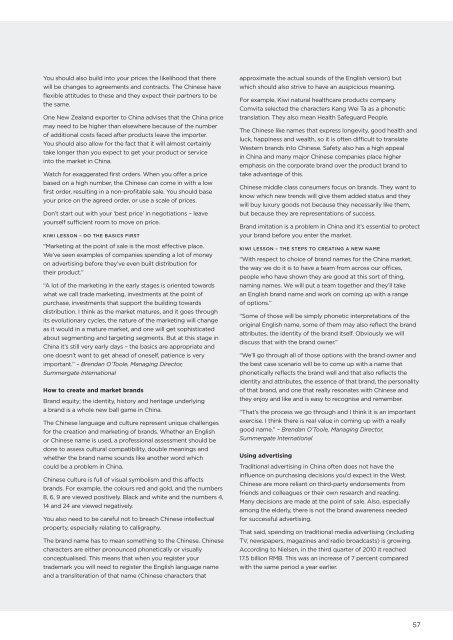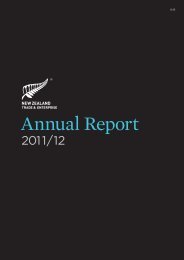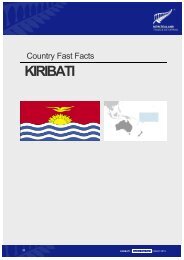Navigating China Guide (2012) - New Zealand Trade and Enterprise
Navigating China Guide (2012) - New Zealand Trade and Enterprise
Navigating China Guide (2012) - New Zealand Trade and Enterprise
Create successful ePaper yourself
Turn your PDF publications into a flip-book with our unique Google optimized e-Paper software.
You should also build into your prices the likelihood that there<br />
will be changes to agreements <strong>and</strong> contracts. The Chinese have<br />
flexible attitudes to these <strong>and</strong> they expect their partners to be<br />
the same.<br />
One <strong>New</strong> <strong>Zeal<strong>and</strong></strong> exporter to <strong>China</strong> advises that the <strong>China</strong> price<br />
may need to be higher than elsewhere because of the number<br />
of additional costs faced after products leave the importer.<br />
You should also allow for the fact that it will almost certainly<br />
take longer than you expect to get your product or service<br />
into the market in <strong>China</strong>.<br />
Watch for exaggerated first orders. When you offer a price<br />
based on a high number, the Chinese can come in with a low<br />
first order, resulting in a non-profitable sale. You should base<br />
your price on the agreed order, or use a scale of prices.<br />
Don’t start out with your ‘best price’ in negotiations – leave<br />
yourself sufficient room to move on price.<br />
KIWI LESSON – DO THE BASICS FIRST<br />
“Marketing at the point of sale is the most effective place.<br />
We’ve seen examples of companies spending a lot of money<br />
on advertising before they’ve even built distribution for<br />
their product.”<br />
“A lot of the marketing in the early stages is oriented towards<br />
what we call trade marketing, investments at the point of<br />
purchase, investments that support the building towards<br />
distribution. I think as the market matures, <strong>and</strong> it goes through<br />
its evolutionary cycles, the nature of the marketing will change<br />
as it would in a mature market, <strong>and</strong> one will get sophisticated<br />
about segmenting <strong>and</strong> targeting segments. But at this stage in<br />
<strong>China</strong> it’s still very early days – the basics are appropriate <strong>and</strong><br />
one doesn’t want to get ahead of oneself, patience is very<br />
important.” – Brendan O’Toole, Managing Director,<br />
Summergate International<br />
How to create <strong>and</strong> market br<strong>and</strong>s<br />
Br<strong>and</strong> equity; the identity, history <strong>and</strong> heritage underlying<br />
a br<strong>and</strong> is a whole new ball game in <strong>China</strong>.<br />
The Chinese language <strong>and</strong> culture represent unique challenges<br />
for the creation <strong>and</strong> marketing of br<strong>and</strong>s. Whether an English<br />
or Chinese name is used, a professional assessment should be<br />
done to assess cultural compatibility, double meanings <strong>and</strong><br />
whether the br<strong>and</strong> name sounds like another word which<br />
could be a problem in <strong>China</strong>.<br />
Chinese culture is full of visual symbolism <strong>and</strong> this affects<br />
br<strong>and</strong>s. For example, the colours red <strong>and</strong> gold, <strong>and</strong> the numbers<br />
8, 6, 9 are viewed positively. Black <strong>and</strong> white <strong>and</strong> the numbers 4,<br />
14 <strong>and</strong> 24 are viewed negatively.<br />
You also need to be careful not to breach Chinese intellectual<br />
property, especially relating to calligraphy.<br />
The br<strong>and</strong> name has to mean something to the Chinese. Chinese<br />
characters are either pronounced phonetically or visually<br />
conceptualised. This means that when you register your<br />
trademark you will need to register the English language name<br />
<strong>and</strong> a transliteration of that name (Chinese characters that<br />
approximate the actual sounds of the English version) but<br />
which should also strive to have an auspicious meaning.<br />
For example, Kiwi natural healthcare products company<br />
Comvita selected the characters Kang Wei Ta as a phonetic<br />
translation. They also mean Health Safeguard People.<br />
The Chinese like names that express longevity, good health <strong>and</strong><br />
luck, happiness <strong>and</strong> wealth, so it is often difficult to translate<br />
Western br<strong>and</strong>s into Chinese. Safety also has a high appeal<br />
in <strong>China</strong> <strong>and</strong> many major Chinese companies place higher<br />
emphasis on the corporate br<strong>and</strong> over the product br<strong>and</strong> to<br />
take advantage of this.<br />
Chinese middle class consumers focus on br<strong>and</strong>s. They want to<br />
know which new trends will give them added status <strong>and</strong> they<br />
will buy luxury goods not because they necessarily like them,<br />
but because they are representations of success.<br />
Br<strong>and</strong> imitation is a problem in <strong>China</strong> <strong>and</strong> it’s essential to protect<br />
your br<strong>and</strong> before you enter the market.<br />
KIWI LESSON – THE STEPS TO CREATING A NEW NAME<br />
“With respect to choice of br<strong>and</strong> names for the <strong>China</strong> market,<br />
the way we do it is to have a team from across our offices,<br />
people who have shown they are good at this sort of thing,<br />
naming names. We will put a team together <strong>and</strong> they’ll take<br />
an English br<strong>and</strong> name <strong>and</strong> work on coming up with a range<br />
of options.”<br />
“Some of those will be simply phonetic interpretations of the<br />
original English name, some of them may also reflect the br<strong>and</strong><br />
attributes, the identity of the br<strong>and</strong> itself. Obviously we will<br />
discuss that with the br<strong>and</strong> owner.”<br />
“We’ll go through all of those options with the br<strong>and</strong> owner <strong>and</strong><br />
the best case scenario will be to come up with a name that<br />
phonetically reflects the br<strong>and</strong> well <strong>and</strong> that also reflects the<br />
identity <strong>and</strong> attributes, the essence of that br<strong>and</strong>, the personality<br />
of that br<strong>and</strong>, <strong>and</strong> one that really resonates with Chinese <strong>and</strong><br />
they enjoy <strong>and</strong> like <strong>and</strong> is easy to recognise <strong>and</strong> remember.<br />
“That’s the process we go through <strong>and</strong> I think it is an important<br />
exercise. I think there is real value in coming up with a really<br />
good name.” – Brendan O’Toole, Managing Director,<br />
Summergate International<br />
Using advertising<br />
Traditional advertising in <strong>China</strong> often does not have the<br />
influence on purchasing decisions you’d expect in the West.<br />
Chinese are more reliant on third-party endorsements from<br />
friends <strong>and</strong> colleagues or their own research <strong>and</strong> reading.<br />
Many decisions are made at the point of sale. Also, especially<br />
among the elderly, there is not the br<strong>and</strong> awareness needed<br />
for successful advertising.<br />
That said, spending on traditional media advertising (including<br />
TV, newspapers, magazines <strong>and</strong> radio broadcasts) is growing.<br />
According to Nielsen, in the third quarter of 2010 it reached<br />
17.5 billion RMB. This was an increase of 7 percent compared<br />
with the same period a year earlier.<br />
57
















